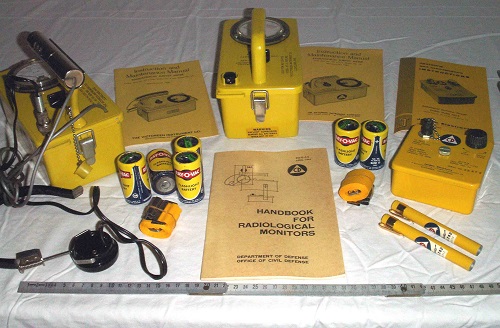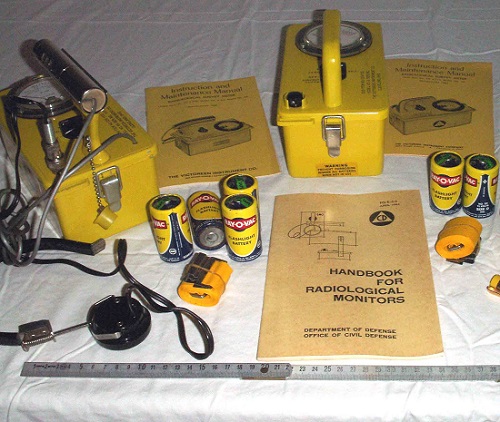So, Dr. Zoomie…our Safety Manager asked me to help figure out what kinds of radiation instruments we should have for our radiation safety program, probably because I’m one of the engineers at work. I want to help out, but I really don’t know what we can use our sodium iodide detector for, if we can measure radiation dose rate with a GM tube, and so forth. Can you help me understand the difference in the types of detectors and what to tell our Safety folks?
Good question! And I’ll tell you, more people make mistakes choosing (or using) the wrong detectors or instruments than anywhere else in radiation safety. And that includes people who have been doing it for a living for years. You didn’t tell me what sorts of radiation sources you have, though, which means I’m going to have to cast a broad net. Let me start with some of the basics. Let’s start with the difference between a detector and an instrument.
The radiation detector is the part of the instrument that (as you might guess) detects the radiation around it. It is possible for the same detector to be connected to two different instruments and to provide different types of information from the same radiation field.
The instrument is the entire system that includes the detector, but that also includes the electronics, the display (or the dial and needle) that shows the user what the detector is seeing. Your eyes, for example, are light detectors but what they pick up is meaningless without your brain to interpret the information they’re collecting. Your visual system includes your eyes, your optic nerve, the visual center of your brain, and the part of your brain that takes that image and tells you that it’s a car.
The two main types of radiation detectors are gas-filled detectors and scintillation detectors. Let’s look at them one at a time.
Gas-filled detectors include Geiger tubes, ionization chambers, and proportional counters. These tend to be sensitive to beta and gamma radiation, and some are sensitive to alpha radiation as well.
Scintillation detectors include a few different materials and each one is only sensitive to one type of radiation. Sodium iodide will detect gamma radiation, zinc sulfide picks up alpha radiation, and plastics like anthracene and stilbene will detect betas.
And there are two primary types of measurements you might want to make – radiation dose rate (to post boundaries or to make health and safety decisions) and radiation count rate (to look for contamination).
For radiation count rate, you only need to be able to tell when an alpha, beta, or gamma has entered your detector – all the instrument is doing is counting how many times in a minute it sees radiation.
Radiation dose and dose rate, though, measure of the amount of energy deposited by the radiation. Here, the total number of counts is not nearly as important as how much energy each count represents. And this is the crux of the matter – you cannot measure radiation dose accurately unless you can tell the difference between high-energy and low-energy radiation.
For example, if the noisy kid sitting in the seat in front of me on this flight turns around and throws something at me it makes a difference what that object is – if it’s a ping-pong ball then it’s annoying, but not dangerous. If it’s a bowling ball then it represents a much higher “dose” because the bowling ball has a much higher weight. If we’re just measuring count rate, the bowling ball and ping-pong ball are both one count – but to know which one is more dangerous we need to know which one has more energy. So – which kinds of detectors are able to measure the energy of the radiation they’re detecting?
Luckily for us we can tell the difference between ping-pong balls and bowling balls fairly easily with no special equipment. Radiation is a bit more challenging, but it’s important to get it right because, otherwise, you can only accurately measure dose rate from the exact radionuclide the instrument was calibrated with and the reading will be too high or too low for any other radionuclide. This means that you might be failing to post places as radiation areas because your meter is giving a reading that’s lower than actual radiation dose rates, or you might be needlessly posting areas because your instrument is giving too high a reading.

Dose and dose rate measurements
To measure the dose rate from beta and gamma radiation the best thing to have is an ionization chamber, and if your dose rate measurements are an important part of your radiation safety program then you really need to get one. All you need to do is to turn it on, hold it in the radiation field for 15 seconds or so, and it will display the dose rate (if it’s an older model then you might have to select the right scale reading – x1, x10, and so forth, but that’s fairly simple; newer units are auto-ranging). Most will have a sturdy piece of plastic that protects a thin aluminum window that’s thin enough for beta radiation to pass through – sliding the plastic back will let you measure beta radiation. And one final choice – if what’s important to you is measuring very low radiation dose rates then you should get a pressurized ionization chamber (PIC); for measuring higher dose rates then a regular instrument (an air ionization chamber) will do the trick.
The biggest problem with ion chambers is that they’re expensive. If your employer has a limited budget – or if you only make a few dose rate measurements each year, you can also make do with an energy-compensated GM detector. This detector is designed so that it filters out many of the low-energy gammas that cause readings to be too high and it lets through more of the high-energy gammas that cause readings to be too low, so the dose rate readings are usually off by no more than 10%, which is good enough for most radiation safety purposes. The down side is that energy-compensated GMs aren’t very good at measuring low-energy gamma radiation (such as what you get from Am-241), nor are most of them sensitive to beta radiation.
Count rate measurements
If you’re looking for contamination (maybe for your semi-annual radioactive source leak test) then normally a Geiger Mueller (GM) tube will do the trick – GMs are fairly rugged, fairly inexpensive, and they detect alpha, beta, and gamma radiation. The major down side with GMs is that they are best at detecting beta radiation and not quite as good for alpha and gamma. Also, they won’t pick up very low-energy beta or gamma radiation at all. A GM is a very versatile detector – I have a few of them in my personal detector case – but sometimes you need something a little more specialized, which is where scintillation detectors come in. Scintillators can usually only do one thing, but they tend to do it very well.
If you’re concerned about gamma radiation, for example, you can’t do much better than a sodium iodide detector. They come in different sizes – the 1”x1” detector is my workhorse, for low-energy gamma radiation I have a thin-crystal detector, and when I need high sensitivity I have one with a larger sodium iodide crystal that’s 2”x2”. Each has its purpose, and it’s nice to have the ability to tailor the detector to the task.
For detecting alpha radiation, you’ll probably want to get a zinc sulfide alpha probe (not as much variety here), and maybe a plastic scintillator for beta detection. And if your needs are a little more esoteric, there are scintillation detectors that are designed to detect alpha and beta radiation both (and even to report the count rate for each in a separate display window if you’ve got the right instrument!).
These ought to take you through the most common types of radiation surveys and the most common types of detectors. For anything more advanced or unusual, there’s all sorts of other gear out there. For instance:
- Multiple types of RIIDs for radio-isotopic identification, most of which use sodium iodide or cesium iodide as the detector
- Multiple types of neutron detectors if you have a soil density, well logging, or other device that produces neutrons
- Very large detectors for specialized situations (trying to find lost or stolen radioactive sources from a helicopter or truck for example)
- Instruments that can be set up to be used with multiple detectors
- Specialized detectors to (for example) survey directly for tritium and other hard-to-detect radionuclides
- Laboratory instruments used for precise measurements in research, regulatory, and industrial laboratories
- And so much more!
What all of these have in common is that the instruments tend to be larger, more expensive, and they require more training and experience to operate them properly and to understand the results they’re giving you. As one example, there’s a hand-held detector I’ve used to identify unknown radionuclides – it does a fantastic job at this…and it costs more than my first house.
So – this is a quick run-down that should take you through the majority of tasks and the majority of detectors and instruments. For anything oddball or specialized I’d suggest contacting the RSO at a large research university or hospital – they’re usually fairly experienced and savvy radiation safety professionals who can help steer you in the right direction. You can also look at the Health Physics Society’s website (www.hps.org) and check out the Ask the Experts feature – it could well be that your question has already been answered and, if not, you can post it and see what they have to say.
| Type of survey | Purpose | Type of detector and instrument |
| Contamination | Routine, spill clean-up, sealed source leak test, worker decontamination | “Pancake” GM (general) Sodium iodide (gamma) Zinc sulfide (alpha) |
| Radiation | Routine, shielding check, establishing radiation area boundaries, dose estimates | Pressurized ion chamber (low level) Air ion chamber (regular, high level) Energy-compensated GM (gamma) |
